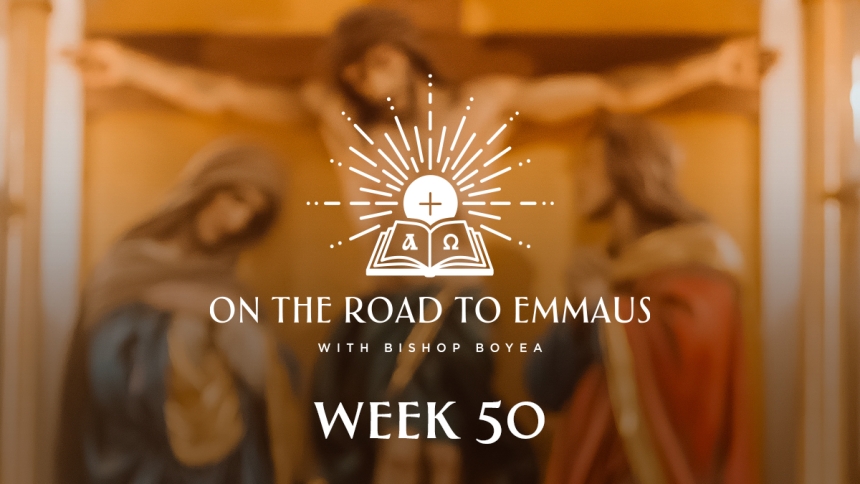
May 24, 2024
Friday of the Seventh Week in Ordinary Time
Dear brothers and sisters in Christ,
My favorite book of the Bible is the Book of Revelation. In Chapter Five, in the midst of a vision of heaven, John laments that no one can open the book with its seven seals. He is then told that “the lion of the tribe of Judah, the root of David,” can do so. Then what shows up? There is no lion. Instead, there is only a lamb and one “that seemed to be slain.” What’s up? Let’s find out this week On the Road to Emmaus.
Where the author of Revelation expected something more powerful than a lamb and perhaps where many at the time of Jesus expected someone more manifestly powerful than he seemed to be, instead this is what we have been given by our Heavenly Father.
John the Baptist, seeing Jesus approach the waters of the Jordan, called out to his own followers, “Behold, the Lamb of God, who takes away the sin of the world” (John 1:29). These are the words the priest uses as he holds up the consecrated bread and wine, “Behold the Lamb of God, behold him who takes away the sins of the world. Blessed are those called to the supper of the Lamb.” And we respond, “Lord I am not worthy.”
Now, clearly the image of the lamb has powerful roots in Jewish history since it was the lamb slain in Egypt whose blood on the door lintels meant safety for the eldest sons of the Jewish people as well as their eventual freedom from Egypt (Exodus 12). We know that Jesus came to be seen as the new Passover Lamb, the one predicted by the prophet Isaiah (53:7): “Though harshly treated, he submitted and did not open his mouth; like a lamb led to slaughter or a sheep silent before shearers, he did not open his mouth.”
When the Ethiopian eunuch asked the Deacon Philip the meaning of this passage from Isaiah, Philip told him all about Jesus. The Ethiopian then was baptized (Acts 8:26-40). Saint Paul even called Jesus, “our Paschal lamb,” the one who had “been sacrificed” (I Corinthians 5:7). Saint Peter also used this phrase (I Peter 1:18-19): “realize that you were ransomed from your futile conduct…not with perishable things like silver and gold but with the precious blood of Christ as of a spotless unblemished lamb.”
So, this lamb that was slain who is held up to us by the priest is not only our food for that day but is the very one who has redeemed us, ransomed us, freed us, and taken away our sins.
There is yet another aspect to this image. We have been called to the supper of the lamb. What supper is this? The Book of Revelation provides us with an answer. After the destruction of Babylon, there is great rejoicing in heaven and the crowd proclaims, “’for the wedding day of the Lamb has come, his bride has made herself ready, she was allowed to wear a bright, clean garment.’ (The linen represents the righteous deeds of the holy ones.) Then the angel said to me, ‘Write this: Blessed are those who have been called to the wedding feast of the Lamb’” (Revelation 19:7-9). It is the Church which is the Lamb’s bride and we as members of the Church find ourselves as part of this wedded union with Christ (Revelation 21:9-22:5).
As we prepare to receive Holy Communion, to join in this great Wedding Feast, we may want a lion but it seems to me that we have a pretty powerful Lamb on our side.
And so to this week’s challenge: I want you to read the writings of some of the Church Fathers on the Eucharist.
The Church Fathers are those towering figures of the early Church. They were great saints and great scholars. Meanwhile, their writings reveal an early Church that believed all that we still believe about Jesus Christ truly present in the Holy Eucharist. If you like, the Church of Christ was, is, and always will be, a Eucharistic Church. I hope you enjoy the reading!
Until we meet again upon On the Road to Emmaus, may God bless you all.
+ Earl Boyea
Bishop of Lansing
